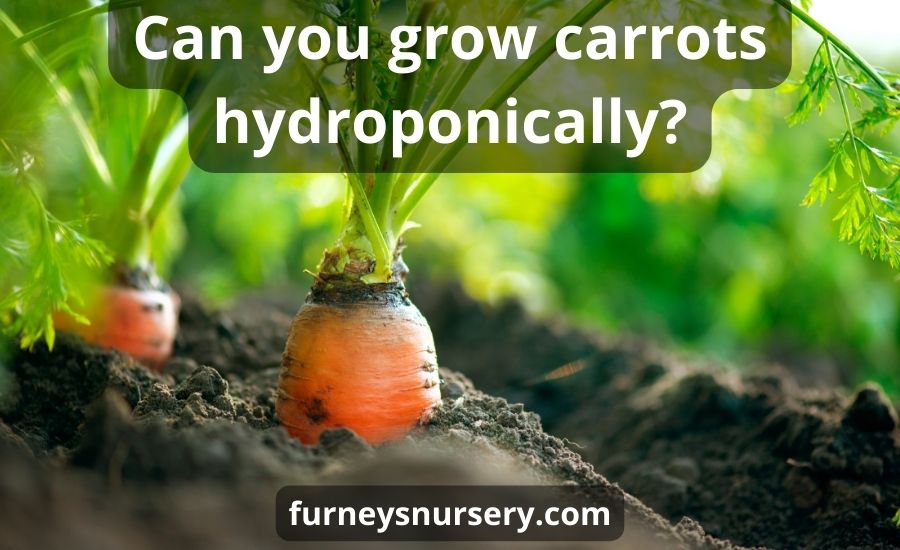If you’ve ever dreamed of growing your own carrots but didn’t have the available space or ideal soil, hydroponic gardening may be the perfect solution for you. In this comprehensive guide, we’ll walk you through the step-by-step process of growing carrots hydroponically, from selecting the right variety to providing the essential nutrients and care they need to thrive. Say goodbye to the limitations of traditional gardening and discover a whole new world of possibilities with hydroponics. Get ready to enjoy a bountiful harvest of fresh, flavorful carrots right in the comfort of your own home.

Preparing for Hydroponic Carrot Farming
When it comes to growing carrots hydroponically, proper preparation is essential for a successful harvest. There are several key factors to consider, including choosing the right carrot variety, setting up a hydroponic system, creating the ideal growing environment, and gathering the necessary equipment. By following these steps, you’ll be on your way to growing healthy and delicious carrots without the need for soil.
Choosing the Right Carrot Variety
Before diving into hydroponic carrot farming, it’s important to select the right carrot variety for your specific needs. Factors such as carrot size, taste, and color can vary greatly depending on the variety. Some popular carrot varieties for hydroponic cultivation include Nantes, Chantenay, and Imperator. Research different varieties and choose the one that suits your preferences and growing conditions the best.
Setting Up a Hydroponic System
The next step in preparing for hydroponic carrot farming is setting up the right hydroponic system. There are various types of hydroponic systems available, including NFT (Nutrient Film Technique), DWC (Deep Water Culture), and media-based systems. Each system has its own advantages and disadvantages, so it’s important to understand your specific needs and choose the one that aligns with your goals.
Creating the Ideal Growing Environment
Creating the ideal growing environment is crucial for successful hydroponic carrot farming. Carrots thrive in moderate temperatures, so maintaining a consistent temperature range of 60 to 70°F (15 to 21°C) is ideal. Additionally, carrots require a humidity level of around 60 to 70%. You can achieve this by using a humidifier or placing a tray filled with water near your hydroponic system. Adequate airflow is also essential to prevent the buildup of moisture and the growth of mold or other pathogens.
Gathering Necessary Equipment
To get started with hydroponic carrot farming, you’ll need to gather the necessary equipment. Some essential items include a grow tent or tray, hydroponic system components (such as pumps, tubing, and a reservoir), grow lights, a nutrient solution, pH meters, and a thermometer. Additionally, you’ll need to have quality carrot seeds, hydroponic medium, and pest control measures on hand. Ensure that all your equipment is clean and in good working condition before starting your hydroponic carrot farm.
Seed Selection and Preparation
Now that you have your hydroponic system ready, it’s time to focus on seed selection and preparation. Choosing quality carrot seeds is paramount to ensuring a healthy and robust crop. Look for reputable seed suppliers and select seeds that are known for their germination rates and disease resistance. It’s also important to determine the germination rate of your chosen seeds, as this will impact the number of seeds you need to sow.

Determining Germination Rate
To determine the germination rate, take a sample of seeds and place them on a moist paper towel or paper plate. Keep the seeds in a warm and dark location, such as a cupboard or germination chamber. After a few days, carefully inspect the seeds to see how many have successfully germinated. The percentage of germinated seeds will give you an idea of the overall germination rate. It’s generally recommended to aim for a germination rate above 80% for optimal results.
Seed Treatment and Pre-soaking
To further maximize seed germination, you may consider treating your carrot seeds before sowing them in your hydroponic system. One common method is pre-soaking the seeds in water for a period of time, usually 12 to 24 hours. This helps soften the seed coat and promotes faster and more uniform germination. After pre-soaking, gently drain the water and transfer the seeds to a damp paper towel or directly into the hydroponic medium.
Hydroponic Mediums for Carrot Cultivation
Hydroponic mediums play a crucial role in supporting the growth of carrots in a soil-less environment. There are several different hydroponic mediums available, each with its own unique properties and benefits. Some common mediums for carrot cultivation include perlite, vermiculite, coconut coir, and Rockwool. Understanding the characteristics and limitations of each medium will help you make an informed decision about which one to use for your hydroponic carrot farm.
Understanding Different Hydroponic Mediums
Perlite is a lightweight volcanic mineral that offers excellent drainage and aeration properties. Vermiculite, on the other hand, retains moisture well and provides good insulation. Coconut coir is a popular choice for hydroponic farming, as it retains moisture and has good water-holding capacity. Lastly, Rockwool is a synthetic material with good water retention and excellent structural stability. It’s important to consider factors such as water retention, aeration, and pH stability when choosing the right medium for your hydroponic carrots.
Benefits and Limitations of Each Medium
Each hydroponic medium has its own benefits and limitations. Perlite, for example, provides great root aeration but doesn’t retain water as well as other mediums. Vermiculite is excellent at retaining moisture but may become compacted over time, reducing its aeration capabilities. Coconut coir offers good water retention and is more sustainable than other mediums, but requires careful pH management. Rockwool provides excellent water retention and stability but requires proper handling due to its potential for irritating skin.
Choosing the Best Medium for Carrots
When choosing the best hydroponic medium for carrots, consider the specific needs and requirements of the carrot plants. Carrots prefer well-draining growing mediums that still retain enough moisture to support their growth. The medium should also provide adequate aeration and pH stability. Take into account factors such as cost, availability, and environmental sustainability. Experimenting with different mediums may be necessary to find the one that works best for your hydroponic carrot farm.

Creating a Hydroponic Nutrient Solution
In hydroponics, providing a balanced nutrient solution is crucial for the healthy growth of your carrot plants. A nutrient solution provides essential macronutrients (such as nitrogen, phosphorus, and potassium) and micronutrients (such as iron, zinc, and manganese) that carrots need to thrive. Understanding the importance of a balanced nutrient solution and formulating a customized solution based on your specific needs is key to successful hydroponic carrot farming.
Importance of a Balanced Nutrient Solution
A balanced nutrient solution ensures that your carrot plants receive the right combination of essential nutrients throughout their growth cycle. Nitrogen promotes leafy growth, phosphorus helps with root development, and potassium aids in overall plant health and disease resistance. Micronutrients play a crucial role in enzyme function and other essential plant processes. Providing a balanced nutrient solution helps prevent nutrient deficiencies or toxicities and promotes optimal carrot growth.
Essential Macronutrients and Micronutrients
Macro and micronutrients play specific roles in the growth and development of carrot plants. Macronutrients are required in larger quantities and include elements such as nitrogen, phosphorus, potassium, calcium, magnesium, and sulfur. Micronutrients, on the other hand, are required in smaller quantities but are equally important for plant health. These include elements such as iron, manganese, zinc, copper, molybdenum, and boron. Ensuring an adequate supply of all these nutrients is crucial for the successful growth of your hydroponic carrots.
Formulating a Customized Nutrient Solution
To formulate a customized nutrient solution for your hydroponic carrot farm, start by understanding the specific nutrient requirements of carrot plants at different growth stages. Consult reliable resources, such as nutrient solution calculators or agricultural universities, for recommended nutrient concentrations. Measure and adjust the pH of your nutrient solution to ensure optimal nutrient uptake by the plants. Regularly monitor and adjust the nutrient solution as needed based on the growth and development of your carrot plants.
Monitoring and Maintaining pH Levels
Maintaining optimal pH levels is essential for the health and growth of hydroponic carrot plants. pH plays a critical role in nutrient availability and uptake, as well as overall plant metabolism. It’s important to understand the optimal pH range for carrots, the importance of pH in the nutrient solution, and the methods available to monitor and adjust pH levels effectively.
Understanding Optimal pH Levels for Carrots
The optimal pH range for carrot plants is generally between 5.5 and 6.5. At this pH range, nutrients are most readily available for absorption by the plants’ root systems. pH levels outside of this range can result in nutrient deficiencies or toxicities, leading to stunted growth and poor crop yield. Regularly monitoring and adjusting the pH of your nutrient solution is crucial for maintaining optimal plant health and maximizing your hydroponic carrot farm’s success.

Importance of pH in Nutrient Solution
pH is a critical factor in hydroponic systems because it affects the availability and uptake of nutrients by plants. Each nutrient has an optimal pH range at which it is most efficiently absorbed by plant roots. Deviations from this optimal pH range can lead to nutrient imbalances, affecting plant growth and overall performance. Maintaining the appropriate pH levels in your nutrient solution helps ensure that your carrot plants have access to the necessary nutrients they need for healthy growth.
Methods to Monitor and Adjust pH
There are various methods available to monitor and adjust pH levels in your hydroponic system. pH meters and test strips are commonly used tools to measure the pH of your nutrient solution. Regularly test the pH and adjust it as needed using pH up or down solutions. These products can raise or lower the pH, respectively. Additionally, maintaining a stable pH range also relies on proper water quality, as certain minerals or contaminants can affect pH levels. Consider the use of reverse osmosis water or other water treatment methods to ensure optimal pH stability.
Providing Adequate Lighting
Providing adequate lighting is crucial for the successful growth of any hydroponic crop, including carrots. Carrots require full-spectrum light for photosynthesis and proper development. Understanding the lighting requirements for carrots, the types of artificial lighting available for hydroponics, and how to set up an efficient lighting system will help ensure optimal carrot growth and yield.
Assessing Lighting Requirements for Carrots
Carrots require full-spectrum light, consisting of both blue and red wavelengths, for photosynthesis. Blue light promotes leaf and stem growth, while red light stimulates root development and flowering. Carrot plants generally require 12 to 16 hours of light per day for optimal growth. Assess the lighting needs of your specific carrot variety and ensure that your lighting system provides the necessary light intensity and spectrum throughout the different growth stages.
Types of Artificial Lighting for Hydroponics
There are several types of artificial lighting options available for hydroponic carrot farming. LED (Light-Emitting Diode) lights are energy-efficient and can be customized to provide the specific wavelengths needed by plants. Fluorescent lights, such as T5 or CFL (Compact Fluorescent Lamp), are cost-effective and widely used for smaller-scale hydroponic setups. HID (High-Intensity Discharge) lights, such as MH (Metal Halide) and HPS (High-Pressure Sodium) lights, offer high light output but require more energy and potentially generate more heat. Choose the lighting system that best suits your needs, budget, and space requirements.
Setting Up an Efficient Lighting System
When setting up your lighting system for hydroponic carrot farming, consider factors such as light intensity, duration, and spectrum. Position the lights at an appropriate height to ensure even light distribution and prevent light burn on the plants. Use timers or light control systems to maintain consistent light cycles for your carrot plants. Regularly monitor and adjust the lighting system to prevent any issues, such as light imbalances or heat build-up that can negatively impact carrot growth.

Managing Temperature and Humidity
Managing temperature and humidity levels in the growing environment is crucial for the health and productivity of your hydroponic carrot farm. Carrots prefer moderate temperatures and thrive within a specific humidity range. Understanding the optimal temperature requirements for carrot growth, controlling humidity, and preventing heat and cold stress will help optimize your carrot farm’s success.
Optimal Temperature Range for Carrot Growth
Carrots grow best within a temperature range of 60 to 70°F (15 to 21°C). Temperatures outside of this range can result in slowed growth, reduced crop yield, or even plant damage. Provide adequate ventilation and control the temperature using fans, vents, or other cooling systems as needed. Regularly monitor the temperature in your growing environment and make adjustments to maintain a stable and comfortable range for your carrot plants.
Controlling Humidity in the Growing Environment
Maintaining the right humidity level is essential for the successful growth of your hydroponic carrots. Carrots prefer a humidity range of around 60 to 70%. High humidity can increase the risk of fungal diseases, such as powdery mildew, while low humidity can lead to water stress and hinder plant growth. Monitor and adjust humidity levels using humidifiers, dehumidifiers, or ventilation systems to create an environment that promotes healthy carrot growth without excess moisture or dry conditions.
Preventing Heat and Cold Stress
Extreme temperatures can cause stress and negatively affect carrot plants. Avoid exposing your hydroponic carrot farm to extreme heat or cold, as it can result in reduced growth, wilting, or even plant death. Insulate your growing environment to prevent temperature fluctuations and protect your plants from extremes. Use reflective materials or shading techniques to reduce excessive heat, and consider using heaters or insulation during colder periods to maintain a stable and favorable temperature range.
Watering and Irrigation Techniques
Watering and irrigation techniques play a crucial role in hydroponic carrot farming. Proper water management ensures that your carrot plants receive the necessary moisture for growth while preventing overwatering or nutrient imbalances. Understanding hydroponic watering methods, determining watering frequency and duration, and implementing proper techniques will contribute to the success of your carrot crop.
Hydroponic Watering Methods
There are different hydroponic watering methods that can be utilized for carrot cultivation. Two common methods are the drip system and the flood and drain system. In the drip system, water and nutrient solution are delivered directly to the base of the plants through drip emitters or micro sprinklers. This method provides targeted watering and minimizes water waste. The flood and drain system, on the other hand, periodically floods the growing medium with nutrient solution and allows it to drain, providing temporary saturation and aeration. Choose the watering method that works best for your hydroponic setup and carrot variety.
Determining Watering Frequency and Duration
Determining the appropriate watering frequency and duration for your hydroponic carrot farm depends on various factors, such as the age and growth stage of the plants, humidity levels, and environmental conditions. Young carrot plants typically require less water than more mature ones. Monitor the moisture levels in the growing medium regularly and adjust the watering schedule accordingly. Over time, you’ll develop a better understanding of your specific carrot plants’ water needs and be able to provide the right amount of water for optimal growth.
Preventing Overwatering and Nutrient Imbalances
Overwatering can be detrimental to the health of your hydroponic carrot plants. It can lead to root rot, nutrient leaching, and oxygen deprivation. Regularly monitor the moisture levels in the growing medium and ensure that it doesn’t become oversaturated. Adequate drainage and aeration are essential to prevent waterlogging and maintain healthy root systems. Additionally, overwatering can also cause nutrient imbalances, as excessive watering can flush out essential nutrients from the growing medium. Monitoring and adjusting your watering practices will help prevent these issues and maintain optimal growing conditions for your hydroponic carrots.
Controlling Pests and Diseases
Just like traditional soil-based farming, hydroponic carrot farming is also susceptible to pests and diseases. However, implementing preventive measures and proper pest control can help minimize infestation and ensure the health of your carrot plants. Understanding common carrot pests and diseases, implementing preventive measures, and considering natural and chemical pest control options will help you maintain a thriving hydroponic carrot farm.
Common Carrot Pests and Diseases
Carrot crops can be affected by a range of pests and diseases. Some common pests include aphids, spider mites, carrot flies, and nematodes. These pests can damage the foliage, roots, or even transmit diseases to your carrot plants. Diseases such as powdery mildew, root rot, and damping-off can also affect carrot crops and reduce their productivity. Regularly inspect your plants for signs of pests or diseases and take immediate action to prevent their spread.
Preventive Measures to Minimize Infestation
Prevention is key to minimizing pest and disease infestation in your hydroponic carrot farm. Start by maintaining proper sanitation practices, including cleaning and disinfecting your hydroponic system regularly. Avoid introducing pests or diseases by using high-quality seeds from reputable suppliers and sourcing clean and disease-free growing mediums. Implement physical barriers, such as sticky traps or mesh nets, to prevent pests from accessing your plants. Regularly inspect and monitor your carrot plants for signs of trouble, and promptly address any issues that arise.
Natural and Chemical Pest Control Options
In hydroponics, natural pest control methods are often preferred due to concerns about chemical residue and environmental impact. Beneficial insects, such as ladybugs or predatory mites, can help control pest populations naturally. Additionally, using organic insecticides or botanical extracts can effectively deter or eliminate pests without harming your crops. However, in severe cases or when natural methods fail, chemical pest control options may need to be considered. If using chemicals, carefully follow the instructions and ensure that the products are safe for hydroponic use and won’t harm your carrot plants or the environment.
Troubleshooting Common Issues
Even with careful planning and implementation, hydroponic carrot farming can still face challenges. Identifying and resolving nutrient deficiencies, addressing pH fluctuations, and dealing with pest and disease problems are common issues that may arise. Developing troubleshooting skills and understanding how to resolve these issues will help you maintain a healthy and productive hydroponic carrot farm.
Identifying and Resolving Nutrient Deficiencies
Nutrient deficiencies can manifest as visible symptoms in the leaves or overall growth of your carrot plants. Yellowing, stunted growth, or necrotic spots can indicate a lack of specific nutrients. Familiarize yourself with nutrient deficiency symptoms and their possible causes to accurately identify and address the problem. Adjust your nutrient solution accordingly, ensuring that all essential macronutrients and micronutrients are present in adequate concentrations.
Dealing with pH Fluctuations
pH fluctuations can occur in hydroponic systems and impact nutrient availability and plant health. Periodically monitor the pH of your nutrient solution and adjust it as needed using pH up or down solutions. Regularly calibrate your pH meter to maintain accuracy. If you’re experiencing persistent pH fluctuations, consider reviewing your water source and quality, as certain minerals or contaminants can affect pH stability. Implement buffering agents or pH stabilization techniques to maintain a stable pH range throughout your hydroponic carrot farm.
Addressing Pest and Disease Problems
Despite your best efforts, pests and diseases can still present challenges in your hydroponic carrot farm. Promptly identify and address pest or disease issues to prevent their spread and minimize damage to your crops. Monitor your plants regularly for signs of pests or diseases, such as yellowing leaves, webbing, or necrotic spots. Consult reputable resources or seek the advice of local experts to identify the specific pest or disease and determine the appropriate treatment options. Implement proper pest management practices, such as introducing beneficial insects or using organic pesticides, to control infestations while minimizing harm to your carrot plants and the environment.
By following these comprehensive guidelines and understanding the specific requirements of growing carrots hydroponically, you’ll be well-prepared to embark on your hydroponic carrot farming journey. Remember to continuously monitor and adjust your systems and practices as needed to optimize the health, growth, and productivity of your carrot crop. With dedication, knowledge, and ongoing learning, you’ll have a bountiful harvest of nutritious and delicious hydroponically grown carrots. Happy farming!



